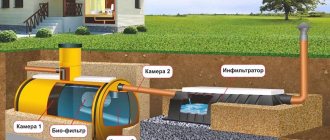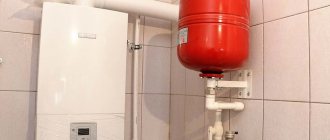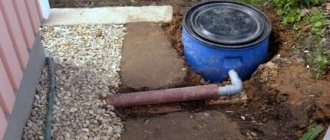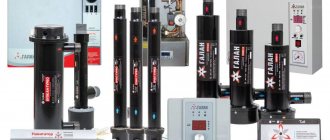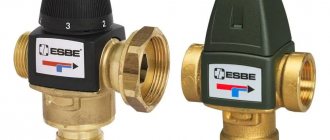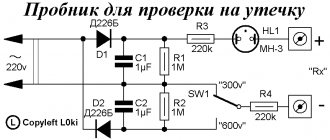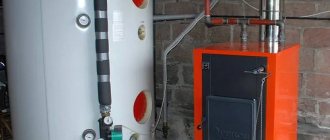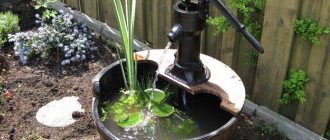The well-being of a private household, especially in humid areas, provides good drainage that removes excess water, including polluted water. The presence of wastewater, groundwater and storm water requires the installation of at least one drainage well for sewerage on the site, with the discharge or pumping of wastewater.
Drainage well as part of a septic tank Source optopg.ru
Companies producing plastic drainage wells and approximate prices
There are quite a lot of companies providing plastic tanks for the drainage system to the Russian market.
And this figure is constantly growing. However, the market is dominated by 2 companies that are most popular among consumers. "Polyplastic"
This is one of the leaders among Russian manufacturers of plastic products. The company produces a full range of wells used in drainage systems. The range includes welded containers. Their tray versions can be used for installation at turns, pipeline intersections and for system inspection. Trayless products can be used as storage tanks.
The company produces differential tanks, rainwater wells, as well as prefabricated ones of various diameters. The cost of a welded well shaft is about 1,700 rubles per meter for a tank with a diameter of 40 cm, a tray of this size costs from 2,300 rubles, and a telescopic neck from 6,000 rubles.
Review: I purchased Poliplatik products to inspect the drainage system. There are no problems during assembly, nor during operation. Satisfied
The only negative is that during the selection process I could not find the price, which is important for product monitoring.
Wavin
This European company, a leader in the production of plastic products for sewerage, including for drainage systems, produces prefabricated manholes with a diameter of 315, 425, as well as larger models Wavin Tegra 600 and 1000. All of them consist of a corrugated shaft, a telescopic neck , hatch and tray with pipes.
The price for a shaft with a diameter of 425 mm ranges from 7,000 to 21,000 rubles, depending on the length. A tray of this type can cost at least 5,000 rubles.
Review: The Vavin well has been in service for more than 5 years. We are very pleased with the quality; the tank withstood temperature changes without problems. True, the prices are steep.
Design and installation features
You can install a plastic drainage well on your site without specialists. For installation, you will need 1-2 assistants, mainly to lower the container to the bottom. But before this it is necessary to carry out preparatory work.
With a monolithic product everything is simpler; it is almost ready for installation. Disassembled finished products must be assembled according to the instructions. And if you decide to make a tank from a large-diameter pipe, then first you need to cut it to the required length.
In finished products, holes for pipes often already exist, but in home-made products, they are pre-cut in accordance with the diameter of the drains. Rubber seals and plastic couplings are inserted into the holes. All seals are lubricated with sealant to prevent leaks.
After this, they begin to dig and prepare the pit, taking into account several parameters:
- The depth should be such that the points where the pipes enter are below the freezing point of the soil, and the bottom of the container is at least half a meter above the groundwater level.
- You also need to take into account that at the bottom of the pit there will be a cushion of crushed stone 15-20 cm high.
- The width of the pit is 40-60 cm greater than the diameter of the container.
- The hatch will then have to rise 10-15 cm above the ground.
After the pit is dug, its bottom is leveled, and then a cushion of crushed stone is filled in and leveled.
If the area is characterized by a seasonal rise in groundwater, then an additional cement base must be poured onto the bottom.
After the cement has hardened, you can install:
- The reservoir is released to the bottom.
- Use a level to check whether the container is level.
- Connect the pipes for the drainage well to the nozzles. Be sure to treat all connections with sealant.
- The tank is backfilled with a sand-gravel mixture. This is done in layers, each layer being thoroughly compacted.
- Install the plastic cover (hatch).
This completes the installation. If necessary, a drain pump is released into the collector.
Installation video of the Wavin Tegra 1000 well:
Alternative filter units
In addition to the filtration well, aerobic wastewater treatment under natural conditions can be carried out using:
- ground drainage;
- filter trenches;
- biological filter.
In the first case, wastewater from the septic tank first enters the distribution well, and then is distributed through drains - pipes with slots, laid with a slope into trenches, previously filled with gravel or crushed stone. The top of the pipes is also sprinkled with crushed stone, then with earth and covered with geotextile. Read more about how to correctly calculate the slope of a drainage pipe in this article.
Scheme of organizing soil drainage on the site. Part of the treated wastewater goes into the ground, and part is absorbed by plants
If there is a body of water near the site where purified water can flow, then filter trenches are installed. Drainage pipes are laid in the bottom layer on a gravel bed, which are then covered with gravel and sand. Drainage pipes with slots are laid on top of the gravel layer, covered with geotextile and covered with earth.
If it is impossible to organize filter fields on the site, install a biofilter. It receives pre-purified water from the septic tank for further biological treatment. As a result of filtration, wastewater is purified to the level of technical water, which then goes into the ground.
The biofilter has an oxygen intake system to activate the activity of aerobic bacteria that oxidize the incoming wastewater.
Types of drainage wells according to their functions
When arranging a drainage system, several types of tanks can be used, which differ from each other in their function and have design features.
- Inspection wells have a hard bottom; they are necessary for inspecting and cleaning the drainage system. They are installed every 20-30 meters on a straight pipeline and at pipe turns. Therefore, they often also serve as rotary ones, which is facilitated by the presence of several inlet pipes located at different angles. At least 2 pipelines enter such a container. Unused holes are hermetically sealed with special plugs.
- Storage tanks are designed to collect water and are installed at the end of the drainage system. These are completely sealed tanks, into which drainage pumps are sometimes released to empty the tank. The water accumulated in the tank can be used for technical needs. It is recommended to equip drainage tanks with sludge receptacles, so the pipes enter the tank at a height of at least 15 cm from the bottom. The inlet pipe is equipped with a valve that prevents the reverse flow of water into the system.
- Storage tanks are in some cases connected to an absorption well that has no bottom. This is a variant of soil filtration. A filter is installed at the bottom of the tank.
- In regions where excessive saturation of the soil with groundwater or atmospheric water occurs, at least seasonally, in some places pipes overflow and pressure increases in drainage. To combat this phenomenon, expansion wells are installed in particularly difficult places, which dampen the fluid pressure in the system. The principle of operation is that water from a narrow pipeline under natural pressure enters a large tank. Due to this, as well as the presence of special energy-absorbing structures inside the tank, the flow rate and pressure in the network drops.
- In places where pipelines run at different depths, drop wells are installed. Such containers are necessary where there is a large difference in relief height. The pipes in them are located at different levels. In some cases, such containers are used as a collector, which is connected to a pipeline that evacuates water collected from the site into a reservoir, ravine, etc.
- Storm wells are used in stormwater systems, which differ from drainage primarily in the depth of the gutters. A drainage well is also used in storm drainage.
Ready-made drainage wells differ not only in the functions they perform, but also in their design features.
What is a drainage well
What is a drainage well? This is a design that helps get rid of excess moisture in the area. Thanks to the varieties, it is possible to avoid flooding of the area and protect buildings from dampness.
Functions
Drainage wells perform the main function of removing moisture from buildings and from the ground surface. So:
- They are built in those regions that are more prone to flooding.
- Climatic conditions in the region also play a big role.
Advice. If autumn and winter in the region are accompanied by a large amount of precipitation, then a well for drainage will be simply necessary.
Worth considering:
- They are also necessary in areas where there are mine structures and large septic tank systems (see Distance from well to septic tank: the right choice).
- In the event of flooding of these systems, not only the reservoirs on the site become clogged, but also the soil itself is flooded.
On what soils are these structures constructed?
According to all the rules for using the land, installation must take place on any terrain. Recommendations:
- It is especially necessary to build them on clay or clay-sand soils. This is due to the fact that this type of soil on the site is very susceptible to flooding. As a result, it loses its properties and floating soils begin to form.
- They also become dangerous for buildings on the site. Its foundation is exposed to moisture and after this deformation of the structure may occur.
Self-installation of drainage wells
Let's look at how to make a drainage well with your own hands. Depending on the type of well, the methods of its manufacture also differ.
Installation of a plastic storage well
The material for making such a well can be corrugated plastic pipe of various sizes.
Important: Wells of this type must be installed below all drainage pipelines, ensuring unimpeded flow of water to them. 1
A pit is being dug for a future reservoir.
1. A pit is dug for the future tank.
2. The required length of the corrugated pipe is measured, after which it is cut.
3. A sand cushion is poured into the hole or a solid concrete base is created.
4. A prepared container is installed in the prepared pit, which has bends for connecting pipes. Holes for inlet pipes can be made after installing the container in a permanent place. Many ready-made wells already have special outlets, so connecting them to the drainage system is easy.
5. Using bitumen mastic, a plastic bottom is glued to the pipe.
6. Drainage pipes are inserted into the well and the cracks are sealed.
7. The gaps between the walls of the well and the pit are filled with crushed stone, sand or a mixture of sand and cement.
Tip: It is advisable to immediately place a drainage pump inside the well. through which water will be pumped out. You can also use a submersible pump, which will be lowered into the well manually, as needed, or a surface type pump.
8. The storage tank is covered with a lid on top to prevent its contamination, and at this point the installation of the drainage well can be considered completed.
The installation of an inspection-type drainage well with your own hands is carried out according to a similar scheme, except for installing a pump. There is also no need to place it at the lowest point of the site.
Installation of a well made of concrete rings
For the manufacture of concrete wells, it is better to use reinforced rings with a lock. If they are not available, then ordinary concrete products will do. The thicker they are, the longer they will last.
The work is performed using special loading equipment in the following sequence:
1. A pit of the required dimensions is prepared.
2. Sand or gravel is poured onto the bottom of the pit. If a filter container is being made, the thickness of the pad should be at least half a meter.
3. The first ring with the bottom is placed on the pillow. If rings without a bottom are used, then a concrete screed is made from below the first ring.
4. The next rings are laid on top of the previous ones. When installing concrete rings, the seams between them are sealed with concrete mortar or bitumen mastic.
5. When the last ring is installed, holes are made in it (if there are none already) for the entrance of drainage pipes.
6. Pipes are inserted into the holes of the ring, after which all joints are carefully sealed.
7. A cover is installed on top of the well. You can use plastic or metal lids, as concrete products are too heavy.
8. The voids between the walls of the pit and the concrete rings are filled with sand, gravel or crushed stone.
Setting up a drainage well is not a very difficult task. You can handle this kind of work yourself, especially when installing plastic products.
Making a tank from plastic pipes
If you decide to make a well out of a plastic container, but it is missing, you can make it yourself. To do this, you should buy a plastic pipe with a diameter of 35-45 centimeters if you plan to construct inspection and turning objects, and a product with a cross-section of 63-95 centimeters for absorption and collector structures.
In addition, you will need a round bottom and a plastic hatch, the dimensions of which must match the pipes. You will also need rubber gaskets.
Sequence of making a plastic container:
- Cut off a piece of plastic pipe of the required size, which is determined taking into account the depth of the well.
- At a distance of 40-50 centimeters from the bottom, a hole is made for connecting pipelines and equipped with gaskets.
- Attach the bottom to the plastic tank and seal the resulting seams with sealant or bitumen mastic. The process of installing a self-made drainage tank is carried out as described above.
What materials are wells made of?
Drainage wells can be made from different materials that differ in their properties:
1. Concrete. This is a traditional material for making drainage wells. The easiest way to install a structure is from concrete rings installed one on top of the other. The walls and bottom can also be filled with concrete, especially if the drainage well is made by yourself. To do this, it will be necessary to construct formwork. Concrete is a durable and strong material, but with prolonged contact with water it gradually begins to crumble and crack.
2. Brick. They line the walls of a well, the bottom of which is filled with concrete. Brick is less durable than concrete, but it is convenient to lay even alone. It is rarely used for the manufacture of drainage systems.
3. Plastic (polymer) wells. They are increasingly replacing other materials used in drainage systems. Plastic containers have a number of advantages:
- resistance to extreme temperatures. They can be operated in a temperature range of -60+50 degrees;
- plastic is a lightweight material, so the installation of such a structure can be carried out independently, without the involvement of construction equipment;
- Installing a plastic drainage well is quick and easy. If necessary, the material can be easily cut to the required size, which is impossible to do with concrete rings;
- inert to various aggressive substances;
- they are not afraid of corrosion and oxidation;
- have strength comparable to metal and concrete;
- perfectly tolerate mechanical and hydraulic loads;
- plastic containers do not rot and are not damaged by rodents and insects;
- plastic containers can be placed at any depth and in soil with any structure;
- The durability of a plastic tank is about 50 years.
An example of a finished plastic well for drainage
Most often, corrugated pipes of various diameters made of polyvinyl chloride are used as drainage containers. A drainage inspection well, or one having another purpose, made from such pipes, has sufficient rigidity to resist being pushed out of the ground by groundwater.
Features of using filter containers
Absorption tanks are installed in areas where there is slightly moist soil, located at a great distance from natural bodies of water and not equipped with drainage systems. The volume of water required to be pumped should not exceed one cubic meter in 24 hours.
The shape of this type of well can be round with a diameter of up to 150 centimeters or rectangular with an area of maximum 6 sq.m. Typically, plastic containers or concrete rings are used to construct a filter tank.
Absorption-type structures are distinguished by the fact that they are a drainage well without a bottom. Instead, they will equip a filter “cushion” that allows dirty waste liquid to pass through and cleans it of debris. Next, the water is directed into the deep layers of the soil. The depth of such a well in the ground should be at least two meters, and the thickness of the filter pad should be at least 30 centimeters.
Advantages and disadvantages of PVC manholes
For several years now, plastic products have occupied a leading position in the field of water supply and wastewater disposal, including stormwater and drainage systems. This is determined by a whole range of positive qualities of plastic products.
- One of the main advantages is its relatively light weight. Installation and transportation do not require the use of special equipment or access to the installation site. The container is very easy to install with 2-3 people.
- Plastic is a sealed material that is not subject to corrosion. The service life of such products is about 50 years, and no maintenance is required.
- Resistance to aggressive environments and low temperatures.
- High-quality PVC does not release toxic substances into the soil, so drainage containers made from it will not harm the ecological condition of the site.
The light weight of plastic products also has a disadvantage: such a container can easily float in water-logged soil.
But this problem can be dealt with using a concrete base, which is installed at the bottom of the pit and to which the well itself is attached. Another frequently cited disadvantage is the high price. But if you remember that when installing a plastic tank, there is no need to hire special equipment, and the service life is several decades, then it becomes clear that the cost will quickly pay off.
Requirements
When choosing a material, you should take into account the basic requirements for wells. Let's take the following points as an example:
- High tightness.
- Long service life.
- High strength.
- Easy to maintain.
- Ease of installation work.
The most suitable materials are selected to meet these requirements.
Design and purpose
Let's study the drainage well in more detail: what is it and what functions does it perform?
This structure is a reservoir of a certain size buried in the soil. The well consists of a shaft, an upper hatch and a bottom. Absorption-type structures do not have bottoms. The well allows you to accumulate excess moisture entering it from pipelines, control the degree of contamination of drainage pipes, and monitor the degree of filling of the drainage with water.
The drainage well on the site is the most important element, without which the drainage system would very quickly lose its functionality, silt up and cease to fulfill its purpose.
Construction and operation
Any communication system needs care and maintenance. There are two types of maintenance: periodic inspection and mechanical cleaning of the system. Periodic inspection includes inspection and cleaning of sewers and wells. Mandatory inspection is done after heavy rainfalls and floods.
For cleaning you will need a drain pump. It is lowered into the well and fixed at a distance of 1 m from the bottom. Pumping liquid. Water is supplied under pressure - it destroys silt deposits. From time to time, remove the pump and clean the filter. After cleaning, cover the hole with a lid.
Major cleaning is carried out once every 4 years. During the work, deposits on the pipe walls are removed, and, if necessary, the pipeline is repaired or replaced. Parts lying on the surface are cleaned manually. If they are built into the soil, then they are washed once every 10 years in sections, using a hose and pump. It is recommended to use a pneumatic unit with a shaft and cleaning attachment.
To protect the system from flooding, geofabric is used, which is laid during installation. To prevent the structure from freezing in winter, drains are laid below the freezing level of the soil. This extends the service life of deep drainage.
Types of drainage wells
There are several options for designing drainage wells, each of which performs specific tasks. Let's look at these types in more detail:
1. Viewing (inspection) well. Its purpose is to inspect and clean clogged pipes. Such structures are not intended for collecting water. Inspection wells for drainage of small diameter (up to 46 cm) are used for flushing pipelines, while larger products with a diameter of 0.9-2 m allow people to go down inside to carry out cleaning activities. Inspection wells are installed at pipe joints, as well as on very long straight sections of drainage pipelines.
Rotary inspection wells are often used, installed at the intersection of several drainage pipes, at corner points, and also at pipeline turns.
The photo shows a rotary inspection well made of plastic
2. Collector (storage) well. It is installed when the soil on the site is clayey and unable to absorb large amounts of moisture. It is also used in cases where it is impossible to discharge excess moisture outside the site. The construction of a drainage well involves the flow of water into it from the drainage system and its subsequent consumption for all kinds of household needs. Such wells are sealed. There may be several similar structures on the site. If the well is singular, several drainage pipes are connected to it simultaneously.
https://youtube.com/watch?v=YXVIi7M1Yr8
The diameters of plastic pipes for the manufacture of such wells start from 57 cm. The deeper the tank, the slower it will fill, and it is installed at the lowest point of the site, below the passage of the drainage pipes.
Construction of a drainage well with a pump
3. Absorption (filter) well. Its use is advisable in cases where it is not possible to remove drainage water outside the site or into the central sewer system.
The absorption well for drainage is usually more than 2 meters deep. A layer of broken brick, slag or gravel about 30 cm thick is poured into the bottom of the structure, which helps absorb water into the ground. The upper part of the well is covered with geotextile, on top of which a layer of soil is poured.
Absorption wells are often installed as the last stage of wastewater treatment after a septic tank
The use of a filter well is justified on sandy and sandy loam soils with high absorption capacity.
Purpose of viewing structures
An inspection or inspection drainage well is intended for the following work:
- performing routine inspections of the sewerage system;
- monitoring the condition of the pipeline;
- periodic cleaning of pipes;
- carrying out repairs.
An inspection well for sewerage is installed in places where there is a high probability that siltation or contamination of the pipes will occur. Its dimensions are selected taking into account the features of sewerage drainage communications. For small pipelines, inspection wells are created with a diameter of 34 to 46 centimeters.
Where large drainage systems are installed, they are equipped with inspection wells for drainage with an internal diameter of up to 150 centimeters. Some of these containers are equipped with steps for ease of descent into them. A large well can easily accommodate an adult who needs to perform work related to cleaning or repairing pipes.
Cleaning is carried out by washing with a water jet under pressure. One of the types of inspection wells is considered to be rotary devices - they are created at corner joints of pipes for quick sewer cleaning. There is no need to install them at every turn of the pipelines; usually this is done through one corner.
When arranging rotary inspection objects, one should take into account the peculiarities of the drainage system and place them so that all cross or corner sections of the highway can be brought to them.
Classification of underground drainage tanks by type of construction
Based on this criterion, ready-made PVC tanks are divided into 2 categories.
Prefabricated wells consist of several elements that are connected to each other before installation:
- main tray with pipes;
- shaft, which can be a corrugated or smooth pipe;
- two sealing rings for connecting the body (shaft) of the well with the neck or tray;
- neck;
- plastic cover;
- extension cord, the length of which may vary depending on the installation depth.
Such tanks are more versatile, since the length of the shaft can be adjusted depending on the depth, but they are more expensive
It is important to take into account that as the length increases, the resistance of the container body to compression decreases.
Monolithic tanks are more durable and cheaper, but have a standard height and are therefore designed for installation at a certain depth. True, the additional installation of the neck allows them to be deepened a little. Drop and expansion tanks are produced only in this form.
Monolithic and prefabricated products are produced both in Russia and abroad.
What are they for?
Wells are needed for the accumulation and drainage of groundwater, and are also used for control checks of drainage pipes and cleaning the system of silt and debris. The type of tanks is related to their operational focus. However, the principle of the device is the same for everyone. The design includes three main parts:
- the bottom is solid or in the form of a tee, with a device for collecting sludge;
- shaft - drain with corrugated or smooth walls;
- cover - a solid or storm hatch made of metal or plastic.
There are types of containers that do not have a bottom. Sometimes the tanks are sealed with a hermetically sealed hatch to completely prevent the entry of garbage waste along with surface runoff.
Inspection well for inspection of the drainage system
Silt formations and other sediments entering the well through pipes settle at the bottom. Therefore, it must be at least 40 cm below the connected drains.
On topic: Foundation drainage: 3 types + how to do it yourself
Types of drainage wells
There are several options for designing drainage wells, each of which performs specific tasks. Let's look at these types in more detail:
1. Viewing (inspection) well. Its purpose is to inspect and clean clogged pipes. Such structures are not intended for collecting water. Inspection wells for drainage of small diameter (up to 46 cm) are used for flushing pipelines, while larger products with a diameter of 0.9-2 m allow people to go down inside to carry out cleaning activities. Inspection wells are installed at pipe joints, as well as on very long straight sections of drainage pipelines.
Rotary inspection wells are often used, installed at the intersection of several drainage pipes. at corner points, as well as at pipeline turns.
2. Collector (storage) well. Installed when the soil on the site is clayey. unable to absorb large amounts of moisture. It is also used in cases where it is impossible to discharge excess moisture outside the site. The construction of a drainage well involves the flow of water into it from the drainage system and its subsequent consumption for all kinds of household needs. Such wells are sealed. There may be several similar structures on the site. If the well is singular, several drainage pipes are connected to it simultaneously.
The diameters of plastic pipes for the manufacture of such wells start from 57 cm. The deeper the tank, the slower it will fill, and it is installed at the lowest point of the site, below the passage of the drainage pipes.
3. Absorption (filter) well. Its use is advisable in cases where it is not possible to remove drainage water outside the site or into the central sewer system.
Tip: Use this type of well if the total volume of wastewater in your area is not too large (up to 1 cubic meter per day).
The absorption well for drainage is usually more than 2 meters deep. A layer of broken brick, slag or gravel about 30 cm thick is poured into the bottom of the structure, which helps absorb water into the ground. The upper part of the well is covered with geotextile, on top of which a layer of soil is poured.
Absorption wells are often installed as the last stage of wastewater treatment after a septic tank
The use of a filter well is justified on sandy and sandy loam soils. having high absorption capacity.
Tip: If the walls of the absorption well have cracks, it is recommended to lay a layer of geotextile on them, which will filter the water penetrating through them.
Basic principles of drainage arrangement on the site
To install the drainage system, the highest point of the site is selected, and a trench is dug from it with a slope of 2 to 5 cm, two meters deep, where the pipes are laid. Rotary wells are installed in the corners, and inspection wells are installed in the places of nodal connections.
To ensure the natural flow of water through the pipes, a trench for laying a sewerage system is dug at a slope of at least 2 cm from the top point of the site
The end point of the sewer system, where all pipes laid with a slope lead, is a filter or storage well, from where forced or natural drainage of water is carried out.
For the installation of drainage sewerage, it is recommended to use special corrugated pipes with perforation, made of PVC or polyethylene. They have no technical restrictions on installation and are very easy and simple to install. Depending on the size of the outlet holes in the drainage well, you can purchase pipes with a diameter of 50 to 200 mm.
There are small slits throughout the entire area of the drainage pipe, which are necessary for water to seep out from the soil.
For the full operation of the entire sewer system, it is necessary to carry out a number of preparatory measures. Sand is poured into a 5 cm layer at the bottom of the trench and compacted thoroughly. Then the bottom and walls of the ditch are covered with geofabric, which will serve as a filter to prevent siltation of the system.
This is followed by a layer of crushed stone, approximately 10 cm on which a perforated pipe is placed, covered with another layer of crushed stone and wrapped in geofabric with an overlap. On top of this “pie” is poured a layer of earth, which was selected when digging the trench.
To ensure the full functioning of the drainage system, it is necessary to carefully prepare the base and lay the pipes in the manner shown in the photo
What materials are wells made of?
Drainage wells can be made from different materials that differ in their properties:
1. Concrete. This is a traditional material for making drainage wells. The easiest way to install a structure is from concrete rings installed one on top of the other. The walls and bottom can also be filled with concrete, especially if the drainage well is made by yourself. To do this, it will be necessary to construct formwork. Concrete is a durable and strong material, but with prolonged contact with water it gradually begins to crumble and crack.
2. Brick. They line the walls of a well, the bottom of which is filled with concrete. Brick is less durable than concrete, but it is convenient to lay even alone. It is rarely used for the manufacture of drainage systems.
3. Plastic (polymer) wells. They are increasingly replacing other materials used in drainage systems. Plastic containers have a number of advantages:
- resistance to extreme temperatures. They can be operated in a temperature range of -60+50 degrees;
- plastic is a lightweight material, so the installation of such a structure can be carried out independently, without the involvement of construction equipment;
- Installing a plastic drainage well is quick and easy. If necessary, the material can be easily cut to the required size, which is impossible to do with concrete rings;
- inert to various aggressive substances;
- they are not afraid of corrosion and oxidation;
- have strength comparable to metal and concrete;
- perfectly tolerate mechanical and hydraulic loads;
- plastic containers do not rot and are not damaged by rodents and insects;
- plastic containers can be placed at any depth and in soil with any structure;
- The durability of a plastic tank is about 50 years.
Most often, corrugated pipes of various diameters made of polyvinyl chloride are used as drainage containers. A drainage inspection well, or one having another purpose, made from such pipes, has sufficient rigidity to resist being pushed out of the ground by groundwater.
If you are looking for the best dry closets for your home, prices, reviews and features of their operation are described in our separate material.
We described the characteristics of the Brooks pump here. It can do an excellent job of pumping water out of storage tanks.
Equipment
When installing well devices, plastic drains with corrugated walls are used. The kit contains:
- trays - installed with pipes on the bottoms of inspection structures only;
- branch pipes – for connecting inlet and outlet drains;
- monolithic bottom - a sealed base without any holes for drains, used in storage tanks;
- shaft rings - form a reservoir;
- seal rings – serve as connecting elements between the shaft and the neck;
- sealing collar - located between the shaft and the bottom of the structure;
- cover - a hatch that protects the shaft from the penetration of waste waste into the container.
The height of the structure is regulated by the number of well rings. Plastic devices are lightweight, tight and easy to connect drains.
Concrete water intakes are also widely used in drainage construction. Their main advantage is their long service life. However, to assemble such a heavy structure, special lifting equipment is needed.
Drainage wells can be built from reinforced concrete rings, plastic containers, brickwork and even worn-out car tires. Which is better to choose?
Important! Several water collectors of different types can be located simultaneously on the drainage main.
There is no doubt about the strength and durability of concrete and brick water collectors. But they must be coated with special solutions to ensure a reliable level of sealing.
Arranging a mine with reinforced concrete rings is impossible without the use of special equipment, which will require additional funds.
For serious checks, a large-volume well is used, so that a person can fit in it
In terms of price-quality ratio, polymer drainage well devices are the leaders. For greater resistance to soil pressure, they are corrugated and perforated. Plastic drainage structures are manufactured in three formats:
- rectangular;
- cylindrical;
- cone
- The light weight of the constituent elements of the structure allows two or three people to assemble the well, almost manually. The guaranteed service life of plastic drainage wells is up to 60 years.
Types and design of drainage wells
Filter drainage well
All wells of the drainage system are classified according to their purpose:
- Audit. Designed to assess the state of all communications. The inspection shaft must have sufficient volume so that a person can descend there if repairs are necessary. More often, the revision is mounted on extended sections of the system (from 10 meters) or on its turns.
- Perepadny. It is installed if the drainage system is installed on a difficult terrain and the master is unable to maintain its smooth slope in specific areas of the site. Has a sealed bottom.
- Turning. A type of inspection well designed for making sharp bends in the system.
- Absorption (drainage). It is also often called filtering. As a rule, it is installed if it is not possible to discharge accumulated moisture into the city highway. The absorption well is the final point of water removal from the site and is located in its lowest part. The filter shaft does not have a sealed bottom. Instead, a drainage cushion of crushed stone and pebbles is laid.
- Storage (collector septic tank). This is a tank with a sealed bottom to collect rainwater. Subsequently, the liquid is either discharged using a pump into the nearest reservoir/ravine, or used for economic purposes (irrigation, watering).
What type of pump should be used to pump out drainage water?
A pump is a common attribute of all types of wells. To pump out drainage water, both stationary and periodically used pumps are used. For continuous operation, select a pump of small capacity but sufficient power, such as a submersible drainage or drainage float pump.
A powerful and efficient pump is used to periodically pump out silt and sand deposits. If a pump is used to pump out a pond, extract sand, or deepen the bottom of a port, it is probably suitable for getting rid of sediment from a drainage well.
A submersible pump for a well will help you easily pump out liquid from an overflowing container Source abad.uz
Pumps suitable for removing sediments are called differently: mud pump, submersible pump, fecal pump, centrifugal pump, sand pump, hydraulic pump - the question is not the principle of operation or name, but whether this device is intended for pumping out sediments, including silt, sand and even small pebbles.
In principle, any pump according to the technical passport “drainage” should pump out accumulated deposits, but for this it may not have enough power (say, the “Malysh” pump) or steam. Two pumps are usually used to remove deposits. Also, a container of about 200 - 300 liters may be required. The sequence of work is as follows:
- A mud pump pumps water out of a drainage well.
- A water-type pump supplies, as powerfully as possible, clean or settled water from a container or other source.
- A mud pump (for example, Pumpex SK series, Makita, Kärcher, Grandfoss), switched on when the water flow starts, pumps out the turbid water, carrying away sediments.
- Another option for cleaning sediments: a team scoops out sediments with buckets, trowels, and shovels by hand.
The manual cleaning method is the cheapest, but not the cleanest Source megapolis-tula.ru
In any case, drainage storage wells require maintenance using pumps (the water still needs to be pumped out before manual cleaning).
Material of manufacture
Drainage wells made of concrete and plastic
For the manufacture of drainage system wells, two popular types of materials are used:
- Plastic. The polymer is light in weight, which is convenient when installing a system at the dacha with your own hands. In addition, plastic (polyethylene, polypropylene) is resistant to aggressive environments and inert to temperature changes. And special rings in the corrugation of a polymer pipe play the role of stiffeners. That is, such a shaft resists seasonal heaving well and is prone to linear stretching. It is worth considering that it is easier to work with plastic when forming holes for drains. And the polymer lasts for 50 years or more.
- Concrete. Strong, strong and durable material. A well made of concrete rings is firmly secured even in very heaving soil. Due to the fact that the tank is assembled from separate elements, it is possible to install shafts of different heights. Concrete lasts no less than plastic. But when constructing a well, it is necessary to use special equipment, since the mass of the rings is impressive.
If you work carelessly with concrete rings, you can damage the structure of the material. Concrete can crack under strong mechanical stress
Details
Features of excavation work
To build a modern drainage system with your own hands, mark out the construction site and remove the soil. You will need a string with wooden stakes. They are used to designate storm drains and a place for installing a well.
Next, remove the soil using a bayonet shovel, and you can level the edges and bottom of the hole with a shovel. To lay a storm drain, you do not need a large trench depth.
Attention! The pipes are not afraid of frost, so you can lay a well at a depth of no more than sixty centimeters.
The pit for the collector well must be deepened. To collect large volumes of wastewater after rainstorms, a large well should be built. In this situation, you will need a partner to lift the soil to the surface.
Crushed stone is poured at the bottom of the trench with the foundation pit. This measure will protect against soil movement and loss of tightness of the drainage system. Geotextiles are placed on top of the fill to prevent plants from growing into the system.
